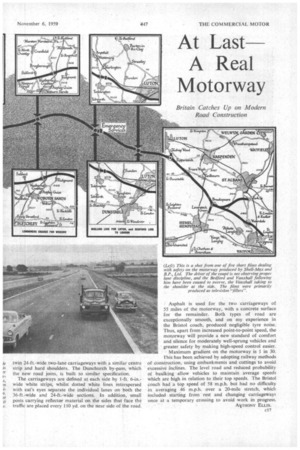At Last A Real Motorway
Page 55

Page 54

If you've noticed an error in this article please click here to report it so we can fix it.
Britain Catches Up on Modern Road Construction
THE London-Birmingham motorway, designated Ml, which was opened to traffic last Monday, is in one word magnificent. After travelling the full length of the new road in both directions three days before the official opening, I think it is apparent that in one giant stride Britain has caught up with the most modern standards of road construction and design throughout the world.
The driver of the Bristol 41-seat coach in which I was a passenger had just returned with the vehicle from four months' touring across the Channel. Thus, his opinion that "it's better than anything that I have met on the Continent" was particularly valid. I was astounded by the driving facilities offered by the motorway. Once the majority of drivers has had experience of motorway driving, public pressure should ensure the fulfilment of future projects and the attendant trunk-road improvement schemes.
Including the spur roads at each end of the main motorway, approximately 75 miles of new road have been built. MI itself begins at Aldenham on the A41 (at present the extreme southern section is not open, and the motorway cannot be entered until 21 miles north of this point at the junction with the A405) and extends north to Crick, Northants. Just before cl 6 , Crick at the Watford gap, a spur road to Birmingham branches off to the beginning of the Dunchurch by-pass and a similar spur at the southern end connects with the A5 on the London side of St. Albans. All other intersections and the spur road to the A6 at Luton are shown on the map above.
The main Ml route is made up of dual, 36-ft.-wide three-lane carriageways separated by a 15-ft.-wide grasssurfaced centre strip, and bounded on the outside by 8-ft.-wide hard-surfaced shoulders on to which a vehicle can be driven in an emergency. The spur roads consist of twin 24-ft-wide two-lane carriageways with a similar centre strip and hard shoulders. The Dunchurch by-pass, which the new road joins, is built to similar specification.
The carriageways are defined at each side by 1-ft. 6-in.wide white strips, whilst dotted white lines interspersed with cat's eyes separate the individual lanes on both the 36-ft.-wide and 24-ft-wide sections. In addition,. small posts carrying reflector material on the sides that face the traffic are placed every 110 yd. on the near side of the road.
Asphalt is used for the two carriageways of 55 .miles of the motorway, with a concrete surface for the remainder. Both types of road are exceptionally smooth, and on my experience in the Bristol coach, produced negligible tyre noise. Thus, apart from increased point-to-point speed, the motorway will provide a new standard of comfort and silence for moderately well-sprung vehicles and greater safety by making high-speed control easier.
Maximum gradient on the motorway is 1 in 30. This has been achieved by adopting railway methods of construction, using embankments and cuttings to avoid excessive inclines. The level road and reduced probability of baulking allow vehicles to maintain average speeds Which are high in relation to their top speeds. The Bristol coach had a top speed of 58 m.p.h. but had no difficulty in averaging 46 m.p.h. over a 20-mile stretch, which included starting from rest and changing carriageways once at a temporary crossing to avoid work in progress.
ANTHONY ELLIS.












































































































